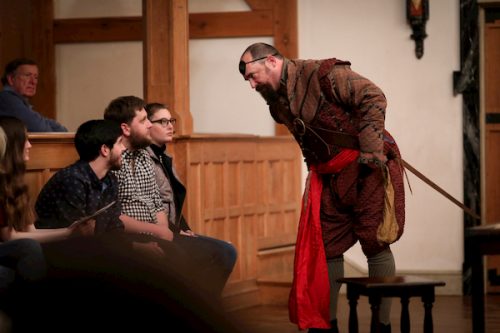O brave new play, that has such people in’t!
When I speak to playwrights about Shakespeare’s New Contemporaries and encourage them to consider writing plays for the project, I frequently hear concerns about the requirement that the play must be able to be performed by an ensemble of 10-12 actors. Writing for large casts undoubtedly presents challenges, but it also creates opportunities: for artistic innovation, for complex dramaturgy, and for inclusive and engaging practices. So today, I offer 10-12 reasons to write a play for 10-12 performers.
1. It’s artistically daring. It encourages playwrights to push back against what they’ve been implicitly or explicitly taught – that theatres in this country are only interested in producing new plays if they have small casts. The more excellent large-cast new plays are written, the more theatres will be encouraged to reconsider their assumptions.
2. It’s economically progressive. Each character you write gives a performer a job. A playwright is a job creator, and great plays for great ensembles will compel theatre companies to invest in people, not buildings.
3. It’s expansive. With a cast of 10-12 actors, a writer can create a whole world on stage. In Shakespeare’s plays, we meet kings and commoners; ghosts and gravediggers; lovers and fighters. (Possibilities for the scope of the playworld are further increased when a playwright writes more characters who can be doubled.)
4. It’s freeing. Sometimes a messenger can just be a messenger. Not every character needs to have an equal sized role in the story that’s being told, and the writer can play around with which characters get the most attention.
5. It’s diverse. More people on stage means more opportunities to represent a variety of experiences on stage. Though not the case when first written, today Shakespeare’s plays are often performed by acting companies whose members include a wide range of ages, gender identities, races, ethnicities, and physical abilities. (ASC’s acting company is deliberately diverse in ethnicity, race, and gender; you can see the current company here. Also noteworthy: our actors comprise a repertory troupe that performs in multiple plays – both new and Shakespeare – within the same season.)
6. It’s relational. Once a playwright has populated their play with so many characters, they are then free to explore all of the relationships therein. In large cast plays, an audience can see familial dynamics, romantic relationships, business partnerships, and more, all in the same play.
7. It’s a puzzle. Taking the above a step further, having a large cast of characters allows for more intricate plot lines and complex communications.
8. It’s energetic and rhythmic. With many characters, diverse relationships, and multiple intertwined plot lines, a writer may begin to explore how the tone and tempo of the play is affected by shifting scene lengths and sizes. (For example, how might an audience lean forward when a public crowd scene is followed by an intimate soliloquy?)
9. It’s engaging. The nature of a smaller cast play generally means that when there are multiple characters on stage, they’re talking to one another. Having a cast large enough for group scenes generates greater opportunity for characters to share interactions, spoken asides, or even just a quick incredulous look with members of the audience.
10. It’s collaborative. Theater is an inherently collaborative form, and a larger company of performers encourages dialogue and creative problem solving.
11. It’s flexible. While SNC asks for plays that can be performed by 10-12 performers, such plays could also be performed by fewer actors – or more – in other production contexts. Shakespeare’s plays are performed by ensembles that vary greatly in size; such flexibility may also be possible for new plays too. (For example, Bill Cain’s Equivocation is written to be performed by 6 actors, each playing several roles. When ASC produced the play in 2018, we got permission to unravel some of the original doubling tracks and perform the play with an ensemble of 11).
12. Who wouldn’t want to work with as many of these talented folks as possible?














